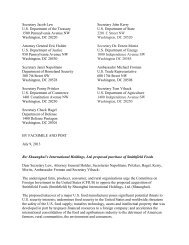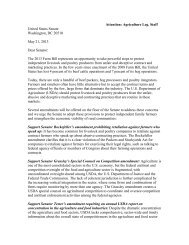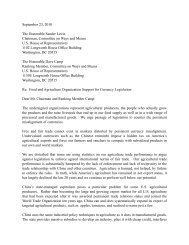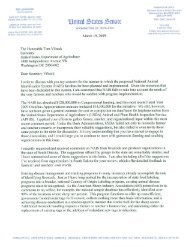Exhibit 8, 100416 Brazil FMD Risk Evaluation - R-Calf
Exhibit 8, 100416 Brazil FMD Risk Evaluation - R-Calf
Exhibit 8, 100416 Brazil FMD Risk Evaluation - R-Calf
Create successful ePaper yourself
Turn your PDF publications into a flip-book with our unique Google optimized e-Paper software.
Imported live animals<br />
The likelihood of exposure of susceptible species to infected live animals was evaluated by briefly<br />
reviewing virus persistence and shedding in live swine and ruminants, as well as standard import<br />
requirements for these species. The exposure assessment focuses on breeding animals because of<br />
high transportation costs for export of other live animals (such as feeder pigs or cattle) to the United<br />
States from <strong>Brazil</strong>. APHIS considers exposure of susceptible U.S. animals to illegally imported<br />
infected live animals from Santa Catarina to be highly unlikely.<br />
The survival period of CSF virus within live swine ranges from 1 week to greater than 6 months,<br />
depending on various host-pathogen factors. Similarly, up to 50 percent of ruminant animals may<br />
become carriers of the <strong>FMD</strong> virus. The maximum reported duration of the carrier state is 3.5 years<br />
in cattle, 9 months in sheep, and 4 months in goats. Carrier virus is fully infectious, and<br />
consequently the carrier state is associated with at least a theoretical risk of introducing <strong>FMD</strong> into a<br />
susceptible population. ASF may also exhibit a chronic carrier state, while SVD virus is not known<br />
to cause persistent infection. A large percentage of infections are subclinical and therefore may<br />
remain undetected without diagnostic testing prior to export [24].<br />
Consequently, APHIS considers this potential pathway to pose a high risk for disease introduction if<br />
unmitigated. However, current U.S. regulations require certification that ruminants and swine have<br />
been kept in a region entirely free of <strong>FMD</strong>, CSF, SVD, and ASF for 60 days prior to export (9 CFR<br />
93.405 and 9 CFR 93.505). They also require a minimum quarantine of 30 days for most imported<br />
ruminants (9 CFR 93.411) and 15 days for all imported swine (9 CFR 93.510). These requirements<br />
serve to partially mitigate the risk of exposure by increasing the likelihood of detection in exported<br />
animals.<br />
Based on the results of the release assessment, APHIS considers the likelihood that animals infected<br />
with <strong>FMD</strong>, CSF, SVD, or ASF virus will enter the United States from Santa Catarina to be very low.<br />
The resultant likelihood of animal exposure to <strong>FMD</strong>, SVD, and ASF viruses via this pathway is<br />
similarly low.<br />
Imported genetic material<br />
Genetic materials have been implicated in the introduction of foreign animal disease into susceptible<br />
populations, as well as the spread of established disease epidemics over considerable distances. For<br />
example, two semen collection centers became infected during the course of the 1997-1998 CSF<br />
epidemic in the Netherlands. Potentially contaminated semen was distributed to 1,680 swine herds<br />
over the course of 5 weeks, during which the disease remained undetected in the donor boars.<br />
Although investigators concluded that only 36 farms had been infected through artificial<br />
insemination, all suspect farms were subject to quarantine and testing, resulting in a tremendous<br />
expenditure of resources [25].<br />
Survival of CSF virus in semen has been estimated in experimental studies to be 12 to 72 hours at<br />
20C, but ranges from 1 month to several years at 4C or below [26]. Survival in embryos and ova is<br />
unknown [26, 27]. <strong>FMD</strong> virus may be present in semen up to 4 days before clinical signs become<br />
APHIS <strong>Evaluation</strong> of the Status of the <strong>Brazil</strong>ian State of Santa Catarina 64











